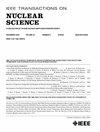一种用于8π伽马射线光谱仪的多功能数字数据采集系统
IF 1.9
3区 工程技术
Q3 ENGINEERING, ELECTRICAL & ELECTRONIC
引用次数: 0
摘要
$8\pi $伽马射线光谱仪是一种高效和选择性的铋锗氧化物球阵列(BGO)探测器。2014年,它从加拿大粒子加速器中心TRIUMF搬迁到西蒙弗雷泽大学核科学实验室(SFU NSL),在那里它已经重新投入使用,升级了用于稀有衰变光谱的组件。在目前的配置中,$8\pi $有12个BGO五边形探测器和60个BGO六边形探测器以二十面体对称排列。它们一起提供132个读出通道和大约95%的立体角覆盖。围绕现有的$8\pi $ BGO探测器,开发了一种独特的数字数据采集系统(DAQ),用于研究稀有衰变。该系统允许通过网络界面对逻辑和数字化参数进行微调,消除了物理重新配置的需要,并提供了前所未有的灵活性。这个升级的DAQ系统包括三个同步的VF48数字化仪,用于波形数字化,两个XLM72S模块用于在线多重滤波,以及用于阈值和堆积处理功能的附加组件。性能指标如能量分辨率、时间分辨率和效率进行了测量,展示了所有$8\pi $子系统的功能。该光谱仪是完全准备的实验要求高效和选择性的时间分辨伽玛射线光谱。$8\pi $在设计时考虑了未来的扩展,可以轻松地支持额外的探测器,使其非常适合广泛的未来实验。本文章由计算机程序翻译,如有差异,请以英文原文为准。
A Versatile Digital Data Acquisition System for the 8π Gamma-Ray Spectrometer
The $8\pi $ gamma-ray spectrometer is a highly-efficient and selective ball array of bismuth germanium oxide (BGO) detectors. In 2014, it was relocated from TRIUMF, Canada’s particle accelerator center, to the Simon Fraser University Nuclear Science Laboratory (SFU NSL), where it has been recommissioned with upgraded components for rare decay spectroscopy. In its current configuration, $8\pi $ has 12 BGO pentagon detectors and 60 BGO hexagon detectors arranged in an icosahedral symmetry. Together, they provide 132 readout channels and approximately 95% solid-angle coverage. A unique digital data acquisition system (DAQ) has been developed around the existing $8\pi $ BGO detectors for the study of rare decays. This system allows for the fine-tuning of logic and digitization parameters through a web interface, eliminating the need for physical reconfiguration and providing a level of flexibility not previously offered. This upgraded DAQ system includes three synchronized VF48 digitizers for waveform digitization, two XLM72S modules for online multiplicity filtering, and additional components for thresholding and pile-up handling functionality. Performance metrics such as energy resolution, timing resolution, and efficiency were measured, demonstrating the functionality of all $8\pi $ subsystems. The spectrometer is fully prepared for experiments demanding efficient and selective time-resolved gamma-ray spectroscopy. Designed with future expansion in mind, $8\pi $ can easily support additional detectors, making it well-suited for a wide range of future experiments.
求助全文
通过发布文献求助,成功后即可免费获取论文全文。
去求助
来源期刊

IEEE Transactions on Nuclear Science
工程技术-工程:电子与电气
CiteScore
3.70
自引率
27.80%
发文量
314
审稿时长
6.2 months
期刊介绍:
The IEEE Transactions on Nuclear Science is a publication of the IEEE Nuclear and Plasma Sciences Society. It is viewed as the primary source of technical information in many of the areas it covers. As judged by JCR impact factor, TNS consistently ranks in the top five journals in the category of Nuclear Science & Technology. It has one of the higher immediacy indices, indicating that the information it publishes is viewed as timely, and has a relatively long citation half-life, indicating that the published information also is viewed as valuable for a number of years.
The IEEE Transactions on Nuclear Science is published bimonthly. Its scope includes all aspects of the theory and application of nuclear science and engineering. It focuses on instrumentation for the detection and measurement of ionizing radiation; particle accelerators and their controls; nuclear medicine and its application; effects of radiation on materials, components, and systems; reactor instrumentation and controls; and measurement of radiation in space.
 求助内容:
求助内容: 应助结果提醒方式:
应助结果提醒方式:


